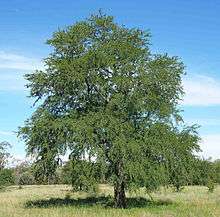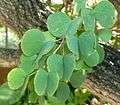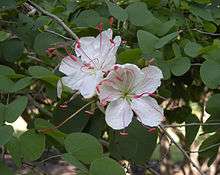Lysiphyllum hookeri
Lysiphyllum hookeri is a species of small tree endemic to Queensland, Australia, of the legume plant family Fabaceae. These trees are known by a variety of common names, including pegunny, alibangbang, Hooker's bauhinia, white bauhinia, mountain ebony and Queensland ebony.[3][4]
| Lysiphyllum hookeri | |
|---|---|
 | |
| habit | |
| Scientific classification | |
| Kingdom: | |
| (unranked): | |
| (unranked): | |
| (unranked): | |
| Order: | |
| Family: | |
| Subfamily: | |
| Tribe: | Bauhinieae[2] |
| Genus: | |
| Species: | L. hookeri |
| Binomial name | |
| Lysiphyllum hookeri (F.Muell.) Pedley | |
| Synonyms | |
| |
Taxonomy
It, along with the rest of the genus Lysiphyllum was formerly treated as part of the genus Bauhinia.[3][5][6][7] However, recent molecular phylogenetic analysis confirms that Lysiphyllum is a distinct genus from Bauhinia.[8][9][10][11][2]
Range and habitat
These trees grow naturally in monsoon forest, littoral rainforest and occasionally in more open forest types in north-eastern Australia.[3] It has also been widely cultivated throughout Australia and the pacific region as a drought-tolerant ornamental plant.[4][12]
Description
As with most members of the genus, this species produces compound leaves with only a single pair of leaflets, producing a bi-lobed leaf that resembles the wings of a butterfly. Showy white flowers are produced throughout the year dependent on rainfall, and are accented by long red stamens. They also have a lovely delicate scent. The flowers are followed by flat pods containing multiple seeds.

foliage 
flowers
References
- The Legume Phylogeny Working Group (LPWG). (2017). "A new subfamily classification of the Leguminosae based on a taxonomically comprehensive phylogeny". Taxon. 66 (1): 44–77. doi:10.12705/661.3.
- Sinou C, Forest F, Lewis GP, Bruneau A (2009). "The genus Bauhinia s.l. (Leguminosae): a phylogeny based on the plastid trnL–trnF region". Botany. 87 (10): 947–960. doi:10.1139/B09-065.
- Hyland, B. P. M.; Whiffin, T.; Zich, F. A.; et al. (Dec 2010). "Factsheet – Bauhinia hookeri". Australian Tropical Rainforest Plants (6.1, online version RFK 6.1 ed.). Cairns, Australia: Commonwealth Scientific and Industrial Research Organisation (CSIRO), through its Division of Plant Industry; the Centre for Australian National Biodiversity Research; the Australian Tropical Herbarium, James Cook University. Retrieved 28 May 2013.
- Rauch FD, Weissich PR (2009). Small Trees for the Tropical Landscape: A Gardener's Guide. Honolulu, Hawaii, USA: University of Hawaiʻi Press. pp. 207. ISBN 978-0824833084.
- "Bauhinia hookeri". Australian Plant Name Index (APNI), IBIS database. Centre for Plant Biodiversity Research, Australian Government. Retrieved 28 May 2013.
- "Lysiphyllum hookeri". Australian Plant Name Index (APNI), IBIS database. Centre for Plant Biodiversity Research, Australian Government. Retrieved 28 May 2013.
- Bostock PD, Holland AE, eds. (2010). Census of the Queensland Flora 2010. Brisbane: Queensland Herbarium, Department of Environment and Resource Management. p. 35. ISBN 978-1920928193. Retrieved 28 May 2013.
- "Lysiphyllum". Legumes of the World. London, England: Royal Botanic Gardens, Kew. Archived from the original (Online, at kew.org) on 15 May 2014. Retrieved 14 May 2014.
- Bruneau A, Forest F, Herendeen PS, Klitgaard BB, Lewis GP (2001). "Phylogenetic Relationships in the Caesalpinioideae (Leguminosae) as Inferred from Chloroplast trnL Intron Sequences". Syst Bot. 26 (3): 487–514. doi:10.1043/0363-6445-26.3.487 (inactive 2020-01-19).
- Herendeen PS, Bruneau A, Lewis GP (2003). "Phylogenetic relationships in caesalpinioid legumes: a preliminary analysis based on morphological and molecular data". In Klitgaard BB, Bruneau A (eds.). Advances in Legume Systematics, Part 10: Higher Level Systematics. Royal Botanic Gardens, Kew. pp. 37–62. ISBN 978-1-84246-054-2.
- Bruneau A, Mercure M, Lewis GP, Herendeen PS (2008). "Phylogenetic patterns and diversification in the caesalpinioid legumes". Botany. 86 (7): 697–718. doi:10.1139/b08-058.
- "Bauhinia hookeri (Mountain ebony)" (Online, at starrenvironmental.com). Plants of Hawaii. Hawaii: Starr Environmental. Retrieved 28 May 2013.